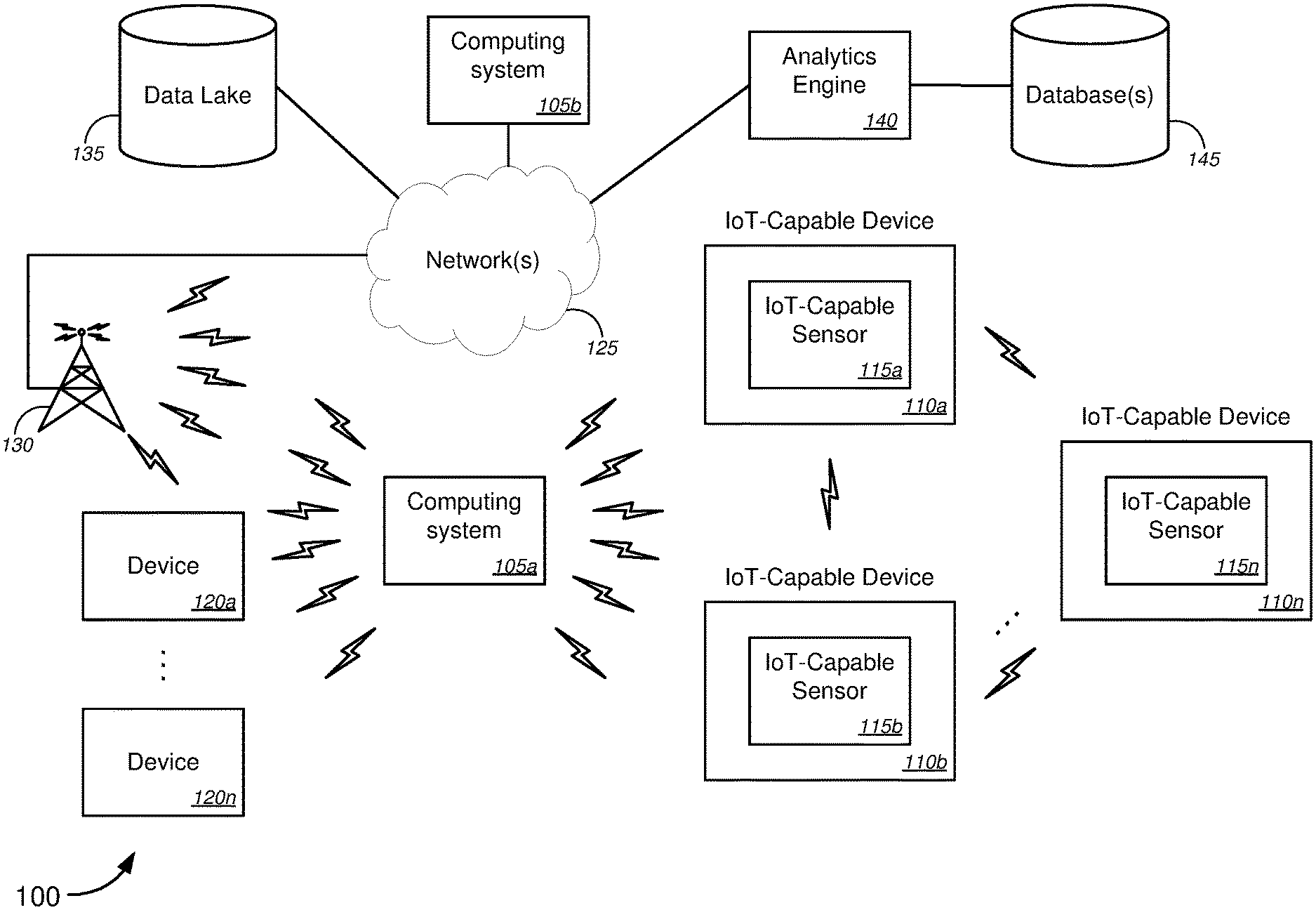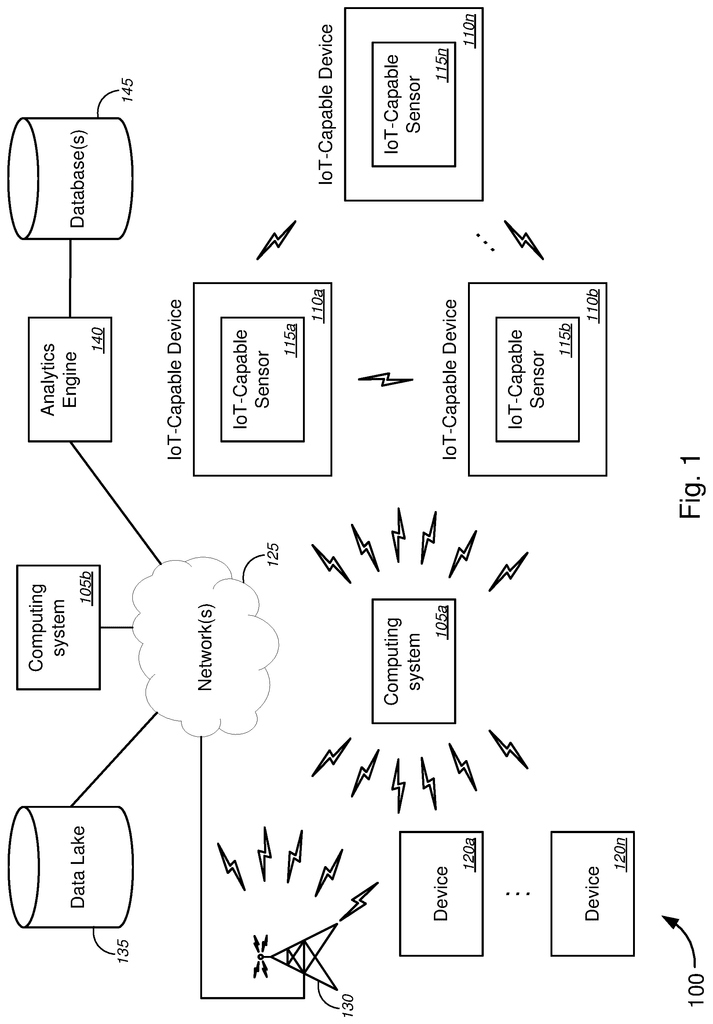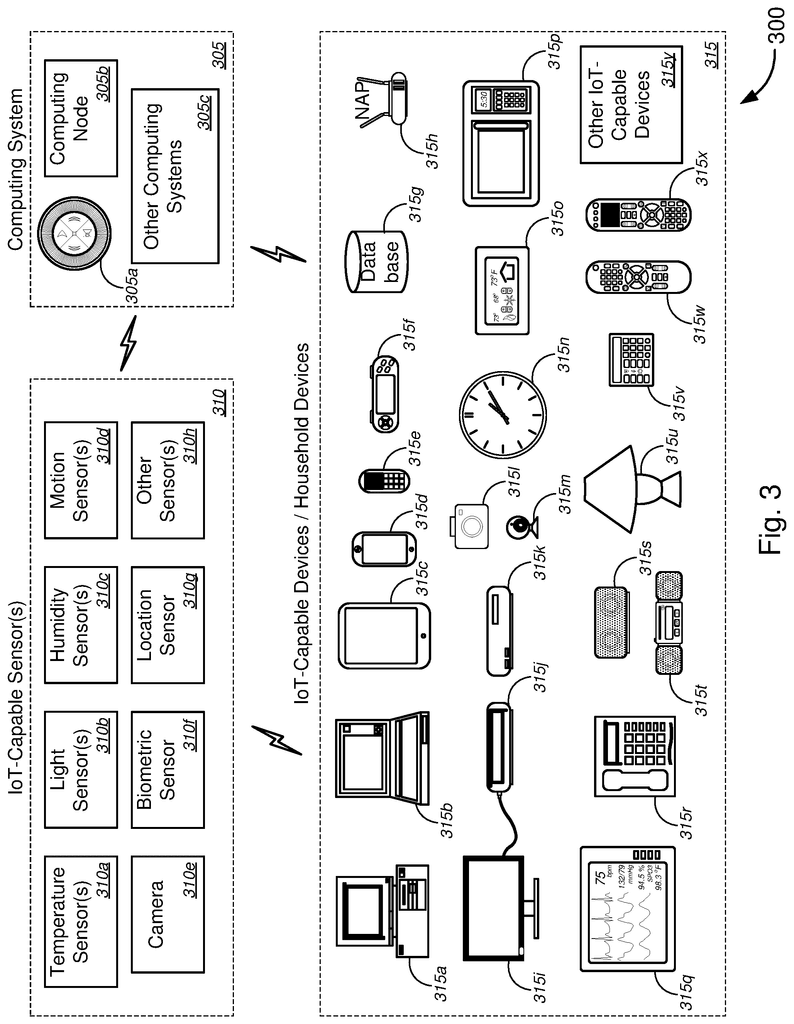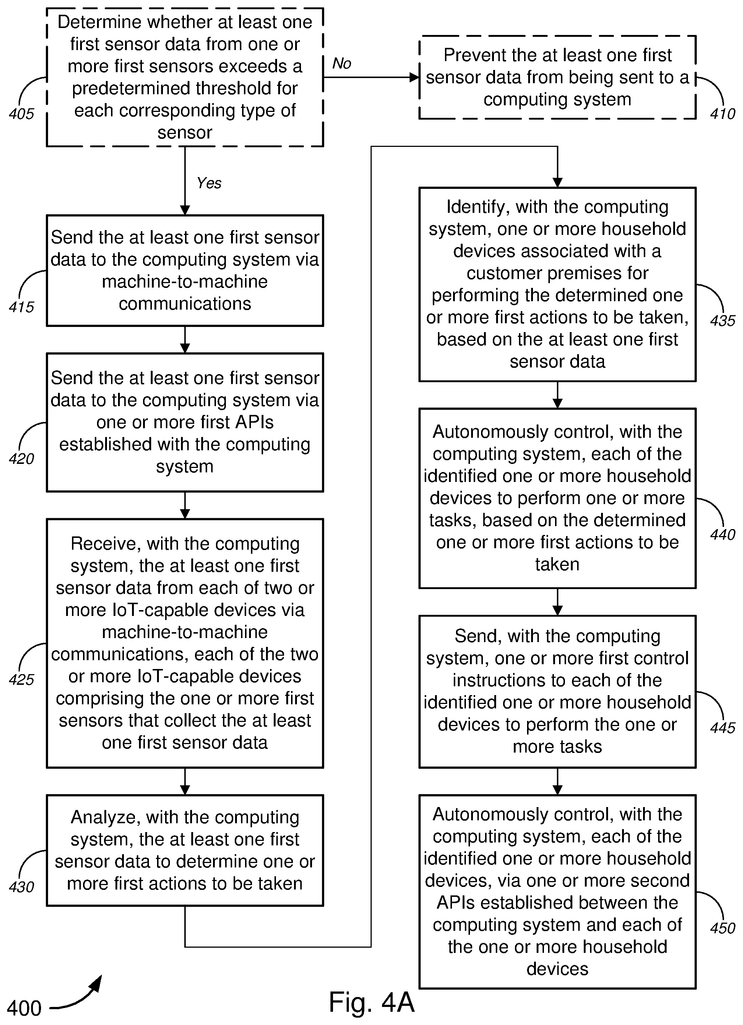Invented by Tom Funk, Phil CARPENTER, William R. Walker, CenturyLink Intellectual Property LLC
Smart vehicle apparatus includes sensors, cameras, and other electronic devices that are used to monitor the vehicle’s performance and environment. These devices can detect potential hazards on the road, such as other vehicles, pedestrians, and obstacles, and alert the driver to take appropriate action. They can also provide real-time information about the vehicle’s speed, fuel consumption, and other important parameters.
Smart vehicle systems are designed to integrate various electronic devices and sensors into a single platform. These systems can be used to control the vehicle’s functions, such as steering, acceleration, and braking, and provide advanced features such as adaptive cruise control, lane departure warning, and automatic emergency braking.
Smart vehicle methods are used to analyze the data collected by the sensors and other electronic devices. This data can be used to improve the vehicle’s performance, reduce fuel consumption, and enhance the safety of the driver and passengers. Smart vehicle methods can also be used to provide real-time information about the vehicle’s location, traffic conditions, and weather.
The market for smart vehicle apparatus, system, and method is expected to grow at a CAGR of 10.5% from 2020 to 2027. The increasing demand for advanced technology in the automotive industry, coupled with the growing awareness about the benefits of smart vehicle systems, is driving this growth.
The Asia-Pacific region is expected to dominate the smart vehicle market during the forecast period. This can be attributed to the increasing demand for electric vehicles, the growing population, and the rising disposable income of consumers in this region. The North American and European regions are also expected to witness significant growth during the forecast period, due to the increasing adoption of advanced technology in the automotive industry.
The major players in the smart vehicle market include Continental AG, Robert Bosch GmbH, Denso Corporation, Delphi Automotive PLC, and Valeo SA. These companies are investing heavily in research and development to develop advanced smart vehicle systems and methods.
In conclusion, the market for smart vehicle apparatus, system, and method is growing rapidly, driven by the increasing demand for advanced technology in the automotive industry. The Asia-Pacific region is expected to dominate the market during the forecast period, while the North American and European regions are also expected to witness significant growth. The major players in the market are investing heavily in research and development to develop advanced smart vehicle systems and methods.
The CenturyLink Intellectual Property LLC invention works as follows
Novel tools, techniques and methods are available to implement Internet of Things (IoT) functionality. A computing system or IoT management device might be able to receive sensor data from IoT-capable sensor devices, analyze it to identify one or several devices, such as household devices associated with customer premises, vehicle components associated with a car, devices placed in, on or along a roadway, devices distributed throughout a community, etc. The first action is performed. The computing system/IoT management node then controls each device to execute the first action. This enables smart environment functionality to be implemented (e.g. smart home, building, customer premises functionality), smart vehicle functionality and smart roadway functionality.
Background for Smart vehicle apparatus, system and method
Internet of Things (IoT) is being implemented in some commercial settings. Although Internet of Things (?IoT) is being used in commercial settings at the moment, these conventional IoT deployments don’t seem to fully exploit the interconnectedness of IoT sensors. Based on sensor data analysis from these IoT sensors, we can determine one or more actions to take and identify one or several devices (e.g., household devices, vehicle components, devices disposed in or on a roadway and/or devices disposed within a community area). to perform the identified one or more actions. These conventional IoT deployments do not appear to autonomously manage each device to perform tasks based upon the actions to be taken.
There is a need to find more robust and scalable solutions to implement Internet of Things functionality. In particular, embodiments to methods, systems and apparatus for implementing smart environmental functionality. This includes without limitation smart home, building, customer premises, smart vehicle functionality and smart roadway functionality. Smart city functionality.
Overview
Various embodiments provide tools, techniques, and methods for implementing Internet of Things functionality. In particular embodiments, they relate to methods, systems and apparatus for implementing smart environmental functionality. This includes without limitation smart vehicle functionality and smart roadway functionality as well as smart city functionality.
In different embodiments, a computing device or IoT management Node might receive sensor information from one or several IoT-capable sensor devices, analyze the sensor data and determine one or multiple actions to take, and identify one (e.g., household appliances associated with customer premises; vehicle components associated with a car; devices disposed in or on a roadway; or devices disposed within a community; etc.). to perform the first action. The computing system/IoT management node then controls each device to execute the first action. This enables smart environment functionality to be implemented (e.g. smart home, building, customer premises functionality), smart vehicle functionality and smart roadway functionality.
In some embodiments, customer premises could include a home, building or other customer premises structure (e.g. business premises, commercial offices, schools, industrial buildings, etc. (or the like). In some cases, the computing system used to implement smart home, building or customer premises functionality might include at least one of the following: an IoT human interface device, or a single processor, or a plurality thereof; a computing node located within the customer premises; or another computing system. This might include an IoT management Node (that is either within the customer premises or at remote facilities associated with a service provider); a cloud computing system; a distributed computing platform that integrates computing resources from multiple IoT-capable devices or a combination of these systems and/or the like;
IoT-capable sensors that can be used to implement smart home, building, and customer premises functionality may include one or more temperature sensors (e.g. heat sensors, infrared sensor, thermometers, etc. ), one or more light sensor (e.g. ambient light sensors. luminosity sensors. illuminance sensors. solar light sensors. ), one or several humidity sensors. One or more motion sensors. One or more cameras. One or more biometric sensor (e.g. fingerprint sensors. palm print sensors. footprint sensors. handprint sensors. voice identification sensors. iris scanners. retina scanners. etc. ), one or several location sensors (e.g. global positioning system (?) Devices, global navigation satellite systems (?GNSS?) Devices, other location sensors, etc. devices, other location sensors, etc. One or more conventional thermometers might be installed in one or more of the rooms. In other embodiments, an infrared sensor (?IR?) may also be included. thermometers that are aimed at at least one position in the one-or more rooms, or one, more infrared (?IR?) sensors.
Accordingly to some embodiments, IoT capable devices or household devices might include one or more IoT -capable sensors and/or a desktop computer or laptop computer. A database or data storage device, an access point (?NAP?)? A television or monitor, and a set-topbox (?STB) are all examples. A television or monitor, set-top box (?STB)? Other IoT-capable devices could include, but are not limited to, a personal digital assistant or a fitness tracking device. A printer, a scanner and an image projection device. An automated window opening/closing device. A window locking system. An automated window covering control system. A smart window. An electrical outlet, smart node, power strip, bar, data port, sprinkler system, exercise equipment. One or several of the IoT-capable household devices may also include a furnace, an automatic skylight opening/closing system, one, more humidifiers, or one, more dehumidifiers, or one, more automated mowers, or one, more automated sprinkler systems, or one, more fertilizer dispensers. One or more fire suppression drones, one, or more white noise generators and/or similar.
Simply to give an example, the vehicle could include a car, minivan or pickup truck, as well as a motorcycle, all-terrain vehicle (or a single processor or a plurality of processors disposed therein), a vehicle node, which might also include a vehicle node, a vehicle node, a vehicle truck, semi-tractor-trailer truck truck, a truck, an ambulance, a police vehicle and a fire engine. A computing system to implement smart vehicle functionality may include, but not be limited to, a vehicle Node (or one processor or a plurality thereof), a computing node located within the vehicle or at other computing systems. This could include an IoT management Node (that is either located inside the vehicle or at a customer premises associated to an owner of that vehicle or at a facility associated with a provider that provides services to that owner of that vehicle), a remote server computer, a cloud computing platform, a system that integrates resources, or combination of IoT-capable devices or from several Iot-capable computing systems or the computing systems and/or a combination of these computing systems.
In some cases, IoT-capable sensors that enable smart vehicle functionality may include one or more temperature sensors (e.g. heat sensors, infrared sensor, thermometers, etc. ), one or more light sensor (e.g. ambient light sensors. luminosity sensors. illuminance sensors. solar light sensors. One or more proximity sensors (e.g. vehicle camera-based collision avoidance, the vehicle radar based proximity detection, the car lidar based proximity detection, the vehicle sonar based proximity detector system, etc. ), one or several speed sensors, one, or more cameras, one, or more fuel level sensors (e.g. gasoline tank level sensors or diesel tank level sensor, battery charge level sensing, etc. ), one or several location sensors (e.g. global positioning system (GPS)? Devices, global navigation satellite systems (?GNSS?) Devices, location sensors, etc. One or more sensors, and/or other sensors. One or more sensors could include one, more, or all of the following: one, more or all of the brake sensors; one, more or all air quality sensors; one, more or all carbon monoxide detectors; one, more or all contact sensors (e.g. for the door lock system and the hood ajar detector and the trunk ajar detector), the moon/skylight ajar detector and the window open detector and/or similar); one, more or all audio sensors; one, more accelerometers
In some embodiments, IoT capable devices or vehicular parts might include one or more IoT -capable sensors and/or a vehicle computer, a car engine, or an electronic throttle control (ETC?). system, vehicle brake system and vehicle gear system. A vehicle turn signal system is also included. system, vehicle-based transceiver/communication system, vehicle display device, vehicle headlight system, vehicle turn signal light system, vehicle brake system, vehicle steering system, vehicle brake light system, vehicle headlight system, vehicle instrument gauge cluster, vehicle heads-up-display (?HUD?) Other IoT-capable devices. Other IoT-capable devices may include an automatic door opening/closing, an automated garage door opening/closing, an automated vehicle window covering control and system, a data port. (or the like).
According to some embodiments, the roadway could include at least one of the following: a local road; a main road; a highway; an airport apron; an airport ramp; an airport runway; a canal or lock; and/or the like. A computing system to implement smart roadway functionality may include, but not be limited to, a vehicle or single processor or a plurality thereof, while such processors can be physical or virtual in nature.
Merely to give an example, some IoT-capable sensors that can be used for smart road functionality may include, without limitation: one or more temperature sensors (e.g. heat sensors, infrared sensor, thermometers), etc. ), one or several light sensors (e.g. ambient light sensors. luminosity sensors. illuminance sensor, solar light sensor, etc. ), one or several humidity sensors, one, or more motion sensors. One or more pressure sensors. One or more air quality sensor. One or more sensors could include one or several communications signal detectors. One or two weather station sensors. One or multiple moisture sensors. One or both wind sensors. One or more particulate sensors. One or many impact sensors. Stress sensors. One or more IoT capable sensors may also include IoT sensors. These sensors are detailed above in detail. One or more structural integrity sensors could include, without limitation: at least one of two, or more, global positioning system sensors, or two, or more relative location sensors. The sensor data from these sensors might indicate a change of position of one structural sensor relative to another structural sensor above a predetermined threshold amount. This might indicate that the roadway might be damaged.
In some cases, IoT devices that can implement smart roadway functionality may include one or several of the above IoT sensors. They might also include one, more, or all of the following: one, more power generation nodes; one, more, or all of the following: one, more, or any combination of these components: a vehicle computer, vehicle engine, ETC system, vehicle brake system or vehicle steering system; a navigation system; a vehicle-based transceiver/communication system and/or the similar; and/or the like); and/or the like); and/or the WAP and/or other IoT devices. Other IoT-capable devices may include, but are not limited to, one or two air purifiers, one, more filters or one, more electrostatic particulate collection tools, a fire suppression device, and one or several lights (e.g. LEDs, indicator lamps, warning lights, etc.). (or the like).
Some embodiments might define the population area as a sub-division or collection of sub-divisions. A village, town, city, or municipality could be included. “A smart city”? Or the like. One embodiment of the computing system for implementing smart-city functionality may include at least one of the following: a central node, or one processor or a plurality thereof; however, such processor or processors can be physical or virtual in nature. Another example of computing system might include a management system located at a vehicle traffic control centre, a remote computing system, a cloud computing platform, a distributed computing solution that integrates computing resources from multiple IoT-capable devices or a combination of several of these computing systems
Merely as an example, IoT-capable sensors that can be used to implement smart city functionality may include, without limitation: one or more temperature sensors (e.g. heat sensors, infrared sensor, thermometers), etc. ), one or several light sensors (e.g. ambient light sensors. luminosity sensors. illuminance sensor, solar light sensors. ), one or several weather sensors, one, or more motion sensors. One or more pressure sensors. One or more air quality sensor. One or more other sensors. One or more sensors could include one or several communications signal detectors. One or two weather station sensors. One or multiple moisture sensors. One or both wind sensors. One or more particulate sensors. One or all of the following: one or many stress sensors. One or more IoT capable sensors may also include IoT sensors. These sensors are described in detail below. One or more structural integrity sensors may include, without limitation: at least one one of two or three global positioning system sensors, two or four relative position sensors, embedded in or disposed upon one or several exterior surfaces of at most one or multiple roadways. This includes, but is not limited to, at minimum one of a local roads, a main road or highway, an airfield apron or runway, an airport ramp, or an airport runway, a canal or lock, or portions of one, or more, public pathways (e.g. ), parts of one or more buildings (e.g. government buildings, public buildings, etc. ), portions from one to more buildings (e.g., government buildings, other public buildings, etc. Some embodiments allow for the type of travel path to vary along the traveled path. This could be asphalt, concrete, crushed rock, bridge, railway crossing or runway and/or any other type of structure.
One or more of the IoT capable devices for implementing smart cities functionality may include one or several of the aforementioned IoT sensor and/or one/more battery charging nodes. A vehicle brake system is also included. Other IoT-capable devices may include an automatic door opening/closing device installed in one of the public buildings, a door locking/locking system installed within one of the public buildings, an automated door closing/opening system installed inside one or two public buildings, an automated window covering system installed inside one, more or all of these public buildings, a data port and one or several building climate control systems. “, and/or similar.
In certain aspects, two or more smart home, building, customer premises, smart vehicle functionality, smart roadway functionality and/or smart city functionality may be combined to enhance and expand the overall smart environment functionality and provide seamless IoT functionality across all living spaces.
The following detailed description illustrates some exemplary embodiments in greater detail in order to allow one skilled in the art to use such embodiments. These examples are intended only to illustrate the invention and not limit its scope.
The following description provides a detailed explanation of the various embodiments. However, it will be obvious to those skilled in the art that the invention can be used in other ways. Other instances show certain structures and devices in block diagrams. There are many embodiments described in this document. While different features are assigned to different embodiments of the invention, it should still be understood that features described in one embodiment can be combined with other embodiments. However, not all features or features described in any embodiment of the invention should be considered essential. Other embodiments may also include such features.
Unless otherwise stated, all numbers used in this application to express quantities, dimensions and so forth should be understood to have been modified in every instance by the term ‘about. Except where otherwise stated, the singular is used in this application. If the application is not specifically stated otherwise, the singular includes the plural. means ?and/or? Except where otherwise stated. The term?includes? is also acceptable. As well as other forms such as ‘includes,? as well as other forms, such as?includes? ?included,? should be considered non-exclusive. Terms such as “element” or “component” should be considered non-exclusive. or ?component? “Comprising both elements and parts that make up one unit as well as elements and parts that make up more than one unit, except where otherwise stated.
Click here to view the patent on Google Patents.









